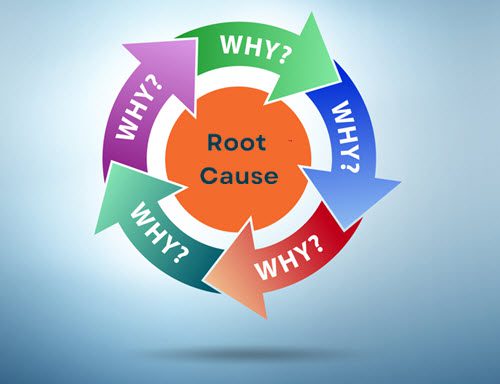 Unraveling the intricacies of equipment failure is an evolving process, often stemming from a series of technical glitches and procedural lapses. In the realm of maintenance, understanding the root causes becomes imperative. This article explores the essence of root cause analysis (RCA) with a focus on the 5 Whys method.
Unraveling the intricacies of equipment failure is an evolving process, often stemming from a series of technical glitches and procedural lapses. In the realm of maintenance, understanding the root causes becomes imperative. This article explores the essence of root cause analysis (RCA) with a focus on the 5 Whys method.
Understanding Root Cause Analysis (RCA)
Before delving into the 5 Whys method, it’s essential to grasp the broader concept of root cause analysis (RCA). RCA is a systematic process designed to unearth the underlying causes of problems or incidents, steering towards effective solutions. The goal is not just to address symptoms but to diagnose and rectify the primary or “root” causes. In pursuit of this goal, Root Cause Analysis (RCA) endeavors to identify and implement enduring solutions that effectively prevent the recurrence of problems over the long term.
For equipment failures, the visible glitch is merely the tip of the iceberg. The 5 Whys method, a subset of RCA, acts as a probe to unveil cause-and-effect failure paths, aiding in a comprehensive understanding.
What is the 5 Whys Method?
The 5 Whys method is an iterative interrogative technique used to explore the cause-and-effect relationships underlying a particular problem. It was originally developed by Sakichi Toyoda and is used to determine the root cause of a defect or problem by successively asking “why” about five times. It is a powerful and straightforward approach to root cause analysis, focusing on asking why a problem happened and asking four more “whys” until the main cause is revealed. The 5 Whys method is often used in combination with other problem-solving techniques to amplify its effectiveness in addressing complex issues.
The 5 Whys Method in Action
Exploring the 5 Whys method entails persistently questioning “why” in various ways to reveal the underlying cause of a problem. As an example, a manufacturing company faces delays in product delivery. The investigation progresses:
- Why did the production delay occur?
- Due to a machine breakdown.
- Is there visible or measurable evidence supporting this root cause determination?
- Could another “why” lead to a more plausible root cause?
- Could anything else have contributed to this problem?
- Why did the machine break down?
- The motor malfunctioned.
- Is there visible or measurable evidence supporting this root cause determination?
- Could another “why” lead to a more plausible root cause?
- Could anything else have produced this problem?
- Why did the motor malfunction?
- Lack of lubrication.
- Is there visible or measurable evidence supporting this root cause determination?
- Could another “why” lead to a more plausible root cause?
- Could anything else have contributed to this problem?
- Why was lubrication neglected?
- Absence of a routine maintenance schedule.
- Is there visible or measurable evidence supporting this root cause determination?
- Could another “why” lead to a more plausible root cause?
- Could anything else have produced this problem?
- Why is there no maintenance schedule?
- Reliance on outdated manual processes.
- Is there visible or measurable evidence supporting this root cause determination?
- Could another “why” lead to a more plausible root cause?
- Could anything else have contributed to this problem?
Recognizing the iterative nature of the 5 Whys, it’s essential to pose crucial questions after each iteration to ensure a comprehensive and grounded analysis.
Enhancing the Analysis Process
To fortify the analysis, considerations beyond the 5 Whys are explored, emphasizing investments at each level. Targeting incremental improvements at every stage yields compounded enhancements over time. This holistic approach encourages investments in technical training, preventive maintenance programs, and advanced technologies to predict and prevent failures.
Root Cause Analysis for Maintenance Excellence
In the maintenance context, the 5 Whys framework emerges as a powerful problem-solving technique, bridging the gap between reactive and preventive strategies. It catalyzes systematic problem-solving, especially pertinent for transitioning to preventive maintenance. This approach prioritizes fixing real problems, preventing recurrence, and breaking free from the cycle of breakdowns. As organizations embrace the 5 Whys, they embark on a journey towards sustained operational efficiency and a proactive maintenance paradigm.
 Unraveling the intricacies of equipment failure is an evolving process, often stemming from a series of technical glitches and procedural lapses. In the realm of
Unraveling the intricacies of equipment failure is an evolving process, often stemming from a series of technical glitches and procedural lapses. In the realm of